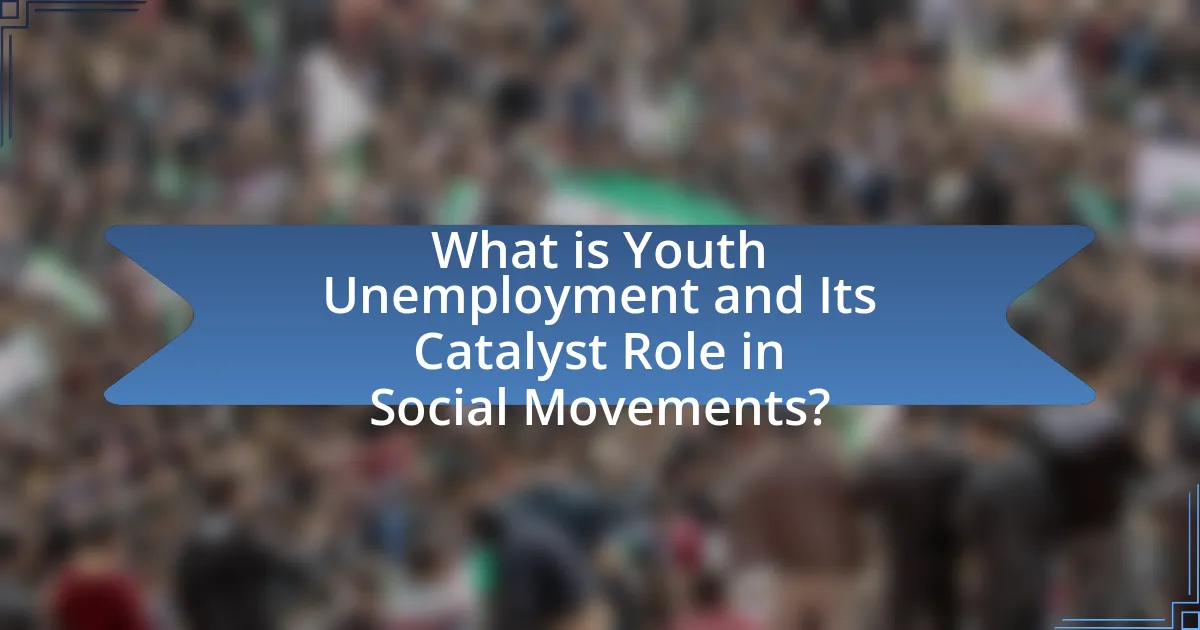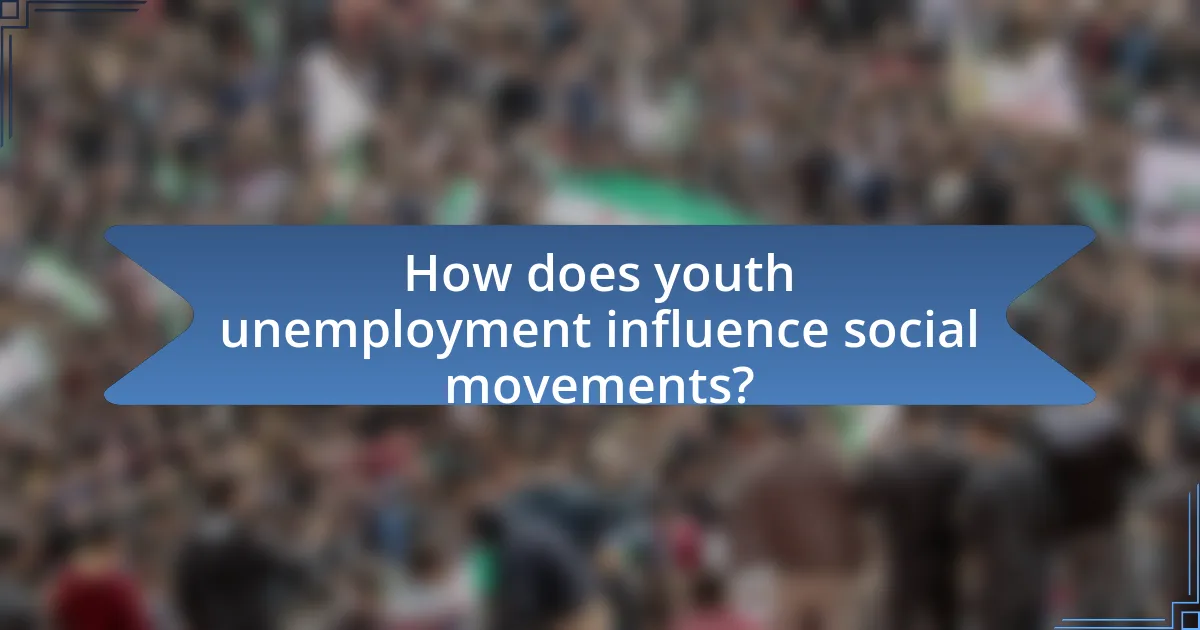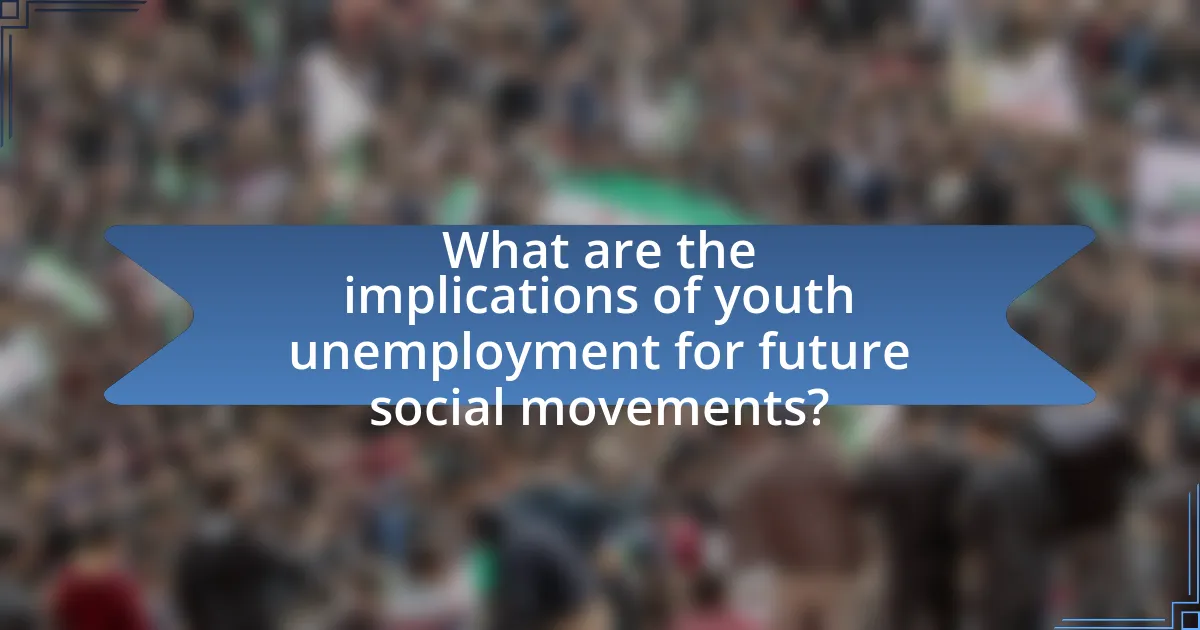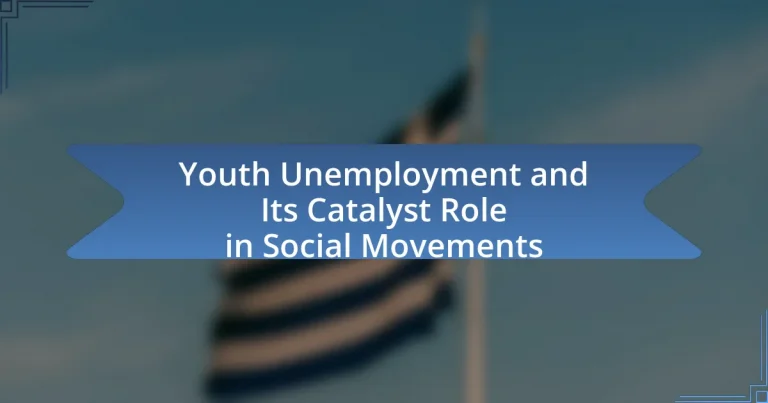Youth unemployment, defined as the inability of individuals aged 15 to 24 to find work despite actively seeking employment, serves as a significant catalyst for social movements. High rates of youth unemployment often lead to frustration and disillusionment, prompting young people to mobilize for political change and social justice, as evidenced by historical events like the Arab Spring. The article explores global youth unemployment statistics, regional disparities, and the psychological effects on individuals, while also examining how economic conditions and government policies influence youth engagement in social movements. Additionally, it discusses the role of technology and education in addressing unemployment challenges and highlights successful community initiatives and advocacy strategies employed by young people to drive policy changes.

What is Youth Unemployment and Its Catalyst Role in Social Movements?
Youth unemployment refers to the situation where individuals aged 15 to 24 are unable to find work despite actively seeking employment. This demographic challenge often acts as a catalyst for social movements, as high rates of youth unemployment can lead to frustration, disillusionment, and a sense of marginalization among young people. Historical examples, such as the Arab Spring, illustrate how youth unemployment can mobilize young populations to demand political change and social justice, highlighting the connection between economic disenfranchisement and collective action. Studies indicate that regions with higher youth unemployment rates often experience increased protests and social unrest, demonstrating the significant role that economic factors play in shaping social movements.
How is youth unemployment defined in the context of social movements?
Youth unemployment in the context of social movements is defined as the phenomenon where individuals aged 15 to 24 are unable to find work, which often leads to increased social unrest and mobilization. This demographic is particularly vulnerable to economic instability, and high rates of youth unemployment can serve as a catalyst for social movements, as disillusioned young people may organize to demand change. Historical examples include the Arab Spring, where youth unemployment rates were a significant factor in the protests, highlighting the connection between economic disenfranchisement and collective action.
What are the key statistics surrounding youth unemployment globally?
Youth unemployment globally stands at approximately 14%, significantly higher than the overall unemployment rate of around 6%. According to the International Labour Organization (ILO), in 2022, around 73 million young people aged 15 to 24 were unemployed. This demographic is disproportionately affected, with youth unemployment rates being three times higher than adult unemployment rates in many regions. Additionally, the ILO reports that the COVID-19 pandemic exacerbated this issue, leading to a 8.7% decline in youth employment in 2020. These statistics highlight the critical challenges faced by young individuals in the labor market worldwide.
How does youth unemployment differ across various regions and demographics?
Youth unemployment varies significantly across regions and demographics, with higher rates typically observed in developing countries compared to developed nations. For instance, as of 2022, the youth unemployment rate in Sub-Saharan Africa was approximately 14%, while in Europe, it averaged around 14% but varied widely, with countries like Greece experiencing rates above 30%. Demographically, factors such as education level, gender, and ethnicity also influence unemployment rates; for example, young women often face higher unemployment rates than their male counterparts in many regions due to societal and economic barriers. Additionally, marginalized ethnic groups frequently experience disproportionately high unemployment rates, reflecting systemic inequalities. These statistics highlight the complex interplay of regional and demographic factors in shaping youth unemployment trends.
Why is youth unemployment considered a catalyst for social movements?
Youth unemployment is considered a catalyst for social movements because it creates widespread frustration and disillusionment among young people, leading them to mobilize for change. High rates of youth unemployment, such as the 2012 European Union average of 23.5%, often result in feelings of hopelessness and marginalization, prompting youth to seek collective action to address their grievances. Historical examples, like the Arab Spring, illustrate how unemployed youth played a pivotal role in initiating protests against oppressive regimes, demonstrating that economic disenfranchisement can ignite demands for political and social reform.
What historical examples illustrate the link between youth unemployment and social movements?
Historical examples that illustrate the link between youth unemployment and social movements include the 1960s civil rights movement in the United States and the 2011 Arab Spring. During the civil rights movement, high youth unemployment rates among African Americans fueled activism and protests against racial segregation and inequality, as young people sought economic opportunities and social justice. Similarly, in the Arab Spring, widespread youth unemployment in countries like Tunisia and Egypt contributed to mass protests against authoritarian regimes, as young people demanded political reform and better economic prospects. These instances demonstrate how economic disenfranchisement among youth can catalyze significant social movements aimed at systemic change.
How do economic conditions influence youth engagement in social movements?
Economic conditions significantly influence youth engagement in social movements by shaping their socioeconomic realities and motivating collective action. High youth unemployment rates, for instance, often lead to increased frustration and disillusionment among young people, prompting them to seek change through activism. Research indicates that during economic downturns, such as the 2008 financial crisis, youth participation in social movements surged, as seen in the Occupy Wall Street movement, which highlighted economic inequality and job scarcity. This correlation suggests that adverse economic conditions can act as a catalyst for youth mobilization, driving them to advocate for policy changes and social justice.
What are the psychological effects of youth unemployment on individuals?
Youth unemployment leads to significant psychological effects on individuals, including increased anxiety, depression, and a sense of hopelessness. Research indicates that unemployed youth often experience diminished self-esteem and social isolation, which can exacerbate mental health issues. A study published in the Journal of Youth Studies found that young people facing unemployment are more likely to report feelings of worthlessness and despair, with 40% of participants indicating that joblessness negatively impacted their mental well-being. Additionally, prolonged unemployment can lead to a loss of motivation and a feeling of disconnection from society, further contributing to psychological distress.
How does unemployment impact mental health and social identity among youth?
Unemployment significantly negatively impacts mental health and social identity among youth. Research indicates that young individuals facing unemployment experience higher rates of anxiety, depression, and feelings of worthlessness, which can stem from the loss of routine, social interactions, and financial independence. A study published in the Journal of Youth Studies found that unemployed youth reported lower self-esteem and increased social isolation, which further exacerbates mental health issues. Additionally, unemployment can lead to a diminished sense of belonging and identity, as work often plays a crucial role in shaping social status and community engagement. The World Health Organization has highlighted that prolonged unemployment can lead to long-term psychological distress, emphasizing the critical need for supportive interventions to address these challenges.
What role does social media play in shaping the experiences of unemployed youth?
Social media significantly influences the experiences of unemployed youth by providing platforms for networking, information sharing, and advocacy. These platforms enable young individuals to connect with potential employers, access job opportunities, and share resources related to employment. For instance, a study by the Pew Research Center found that 70% of job seekers use social media to find employment, highlighting its role in job searching. Additionally, social media serves as a space for unemployed youth to voice their challenges and mobilize for collective action, as seen in various social movements where youth have organized protests and campaigns to address unemployment issues. This dual function of social media as both a job search tool and a platform for activism shapes the overall experience of unemployed youth, making it a critical factor in their engagement with the labor market and societal issues.

How does youth unemployment influence social movements?
Youth unemployment significantly influences social movements by fostering discontent and mobilizing young people to advocate for change. High rates of unemployment among youth often lead to feelings of frustration and disenfranchisement, which can catalyze collective action. For instance, during the Arab Spring, youth unemployment was a critical factor that drove young people to participate in protests against oppressive regimes, as evidenced by reports indicating that countries with higher youth unemployment rates experienced more intense social unrest. This correlation highlights how economic instability can serve as a catalyst for social movements, as unemployed youth seek to address systemic issues and demand better opportunities.
What specific social movements have been driven by youth unemployment?
Specific social movements driven by youth unemployment include the Arab Spring, the Indignados movement in Spain, and the Occupy Wall Street movement in the United States. The Arab Spring, which began in 2010, was significantly fueled by high youth unemployment rates across the Middle East and North Africa, leading to widespread protests against authoritarian regimes. In Spain, the Indignados movement emerged in 2011 as a response to soaring youth unemployment, which reached over 50%, prompting mass demonstrations demanding political and economic reforms. Similarly, Occupy Wall Street, initiated in 2011, highlighted economic inequality and the struggles of young people facing unemployment, galvanizing a broader critique of corporate influence in politics. These movements illustrate how youth unemployment can catalyze significant social and political change.
How do youth-led movements address issues related to unemployment?
Youth-led movements address issues related to unemployment by advocating for policy changes, creating job opportunities, and raising awareness about the challenges faced by young job seekers. These movements often mobilize young people to demand government action, such as increased funding for job training programs and internships. For example, the “Youth Employment Network” has successfully influenced policies in various countries by highlighting the need for youth-specific employment initiatives. Additionally, youth-led organizations frequently collaborate with businesses to develop programs that provide skills training and apprenticeships, directly linking education to employment. This approach not only empowers young individuals but also addresses systemic barriers to employment, making their efforts crucial in combating youth unemployment.
What strategies do these movements employ to raise awareness and advocate for change?
Social movements addressing youth unemployment employ strategies such as grassroots organizing, social media campaigns, and partnerships with educational institutions to raise awareness and advocate for change. Grassroots organizing mobilizes local communities, enabling participants to share personal stories and experiences that highlight the impact of youth unemployment. Social media campaigns leverage platforms like Twitter and Instagram to disseminate information rapidly, engage a wider audience, and create viral content that draws attention to the issue. Collaborations with educational institutions facilitate workshops and discussions that inform students about employment opportunities and skills development, thereby fostering a proactive approach to tackling unemployment. These strategies collectively enhance visibility and drive policy changes aimed at reducing youth unemployment.
How do government policies affect youth unemployment and social movements?
Government policies significantly influence youth unemployment and social movements by shaping economic conditions and labor market opportunities. For instance, policies that promote job creation, such as tax incentives for businesses or investment in infrastructure, can reduce youth unemployment rates. Conversely, austerity measures or cuts to education and training programs can exacerbate unemployment among young people, leading to increased frustration and potential social unrest.
Research indicates that high youth unemployment often correlates with a rise in social movements, as disaffected youth mobilize to demand change. For example, the Arab Spring was partly fueled by high youth unemployment rates in several countries, where government policies failed to provide adequate job opportunities. Additionally, studies show that youth-led movements, such as the March for Our Lives in the United States, often emerge in response to perceived government inaction on issues affecting their futures, including job prospects. Thus, the relationship between government policies, youth unemployment, and social movements is dynamic and interconnected, with policies directly impacting both employment opportunities and the likelihood of youth mobilization.
What types of policies have been effective in reducing youth unemployment?
Active labor market policies, such as job training programs and apprenticeships, have been effective in reducing youth unemployment. These policies provide young individuals with the skills and experience necessary to enter the workforce. For instance, countries like Germany have successfully implemented dual education systems that combine classroom learning with practical work experience, resulting in lower youth unemployment rates. According to the OECD, nations that invest in vocational training and internships see a significant decrease in youth joblessness, with some reporting reductions of up to 30% in youth unemployment rates.
How do policy failures contribute to the rise of social movements among youth?
Policy failures significantly contribute to the rise of social movements among youth by creating unmet needs and frustrations that drive collective action. When governments fail to address issues such as youth unemployment, inadequate education, and lack of opportunities, young people often feel marginalized and powerless. For instance, the global youth unemployment rate reached 14% in 2021, highlighting the inadequacy of existing policies to provide meaningful employment. This discontent can lead to organized protests and movements, as seen in the Arab Spring, where high youth unemployment and government inaction fueled widespread unrest. Thus, policy failures act as a catalyst for youth mobilization, prompting them to advocate for change and seek solutions to their grievances.

What are the implications of youth unemployment for future social movements?
Youth unemployment significantly influences future social movements by fostering discontent and mobilizing collective action among young people. High rates of unemployment, which reached 14.8% globally in 2021 according to the International Labour Organization, create a sense of frustration and disenfranchisement. This demographic is more likely to engage in protests and social activism as they seek to address perceived injustices and demand change. Historical examples, such as the Arab Spring, illustrate how youth unemployment can act as a catalyst for widespread social movements, as young people, facing limited economic opportunities, rallied for political reform and social justice. Thus, the implications of youth unemployment extend beyond economic concerns, shaping the landscape of future social movements by driving youth engagement and activism.
How might the current trends in youth unemployment shape future activism?
Current trends in youth unemployment are likely to catalyze future activism by fostering a sense of urgency and collective action among young people. As unemployment rates among youth remain high, particularly in regions with economic instability, this demographic may increasingly mobilize to advocate for job creation, fair wages, and educational reforms. Historical evidence shows that economic hardship often leads to heightened political engagement; for instance, the 2008 financial crisis spurred significant youth-led movements advocating for economic justice and reform. Furthermore, the rise of social media platforms enables young activists to organize quickly and amplify their messages, making it easier to connect with like-minded individuals and broader social movements. Thus, the intersection of youth unemployment and activism is poised to intensify as young people seek to address systemic issues affecting their futures.
What role will technology play in mobilizing youth around unemployment issues?
Technology will play a crucial role in mobilizing youth around unemployment issues by providing platforms for communication, information sharing, and advocacy. Social media, for instance, enables young people to connect, organize, and amplify their voices regarding unemployment challenges, as evidenced by movements like #BlackLivesMatter and #MeToo, which utilized digital platforms to raise awareness and drive action. Additionally, online job portals and skill development apps facilitate access to employment opportunities and training resources, directly addressing the skills gap that contributes to youth unemployment. According to a report by the International Labour Organization, the use of technology in job matching can significantly reduce unemployment rates among youth by improving access to job information and enhancing employability skills.
How can education systems adapt to better prepare youth for employment challenges?
Education systems can adapt to better prepare youth for employment challenges by integrating practical skills training and fostering partnerships with industries. This approach ensures that curricula are aligned with current job market demands, equipping students with relevant skills. For instance, a report by the World Economic Forum highlights that 54% of all employees will require significant reskilling by 2022, emphasizing the need for educational institutions to focus on skills such as critical thinking, digital literacy, and collaboration. Additionally, implementing internship programs and mentorship opportunities can provide students with real-world experience, enhancing their employability.
What practical steps can be taken to address youth unemployment and its impact on social movements?
To address youth unemployment and its impact on social movements, implementing targeted job training programs is essential. These programs should focus on equipping young individuals with skills that align with current labor market demands, thereby enhancing their employability. For instance, according to the International Labour Organization, youth unemployment rates are significantly higher than the overall unemployment rate, indicating a pressing need for specialized training initiatives.
Additionally, fostering partnerships between educational institutions and local businesses can create internship and apprenticeship opportunities, allowing youth to gain practical experience while contributing to the workforce. Research from the McKinsey Global Institute highlights that effective collaboration between these sectors can reduce youth unemployment by up to 30%.
Moreover, promoting entrepreneurship through access to microloans and mentorship can empower young people to create their own job opportunities. The World Bank reports that youth-led businesses can drive economic growth and innovation, further mitigating unemployment issues.
Lastly, engaging youth in social movements can raise awareness about their employment challenges, mobilizing community support and policy changes. A study by the Pew Research Center found that active participation in social movements can lead to increased political engagement, which is crucial for advocating for youth-friendly employment policies.
What community initiatives have proven successful in reducing youth unemployment?
Community initiatives such as job training programs, mentorship schemes, and entrepreneurship support have proven successful in reducing youth unemployment. For instance, the YouthBuild program in the United States has helped over 150,000 young people gain skills and employment since its inception, focusing on education and vocational training. Similarly, the Prince’s Trust in the UK has supported over 950,000 young people, providing them with the skills and confidence needed to enter the workforce. These initiatives demonstrate a direct correlation between structured support and improved employment outcomes for youth.
How can young people effectively advocate for policy changes related to unemployment?
Young people can effectively advocate for policy changes related to unemployment by organizing grassroots campaigns that raise awareness and mobilize support. These campaigns can include social media initiatives, community forums, and partnerships with local organizations to amplify their message. For instance, the “Youth Employment Coalition” in the United States successfully influenced policy by uniting young advocates to present data on youth unemployment rates, which reached 14% in 2020, significantly higher than the national average. This collective action not only highlighted the urgency of the issue but also pressured policymakers to consider youth-specific employment programs.
